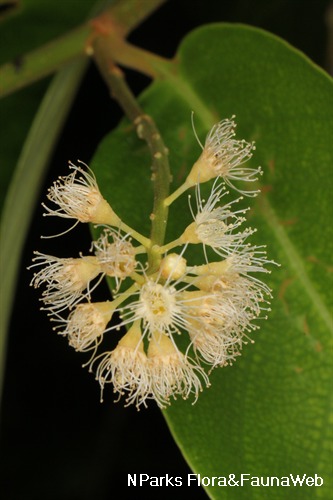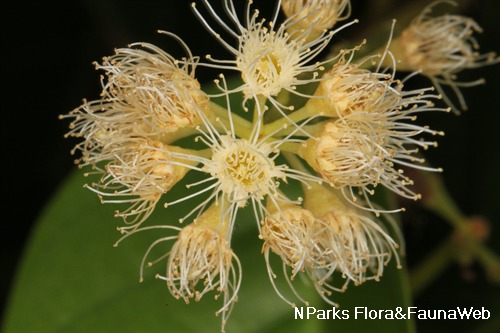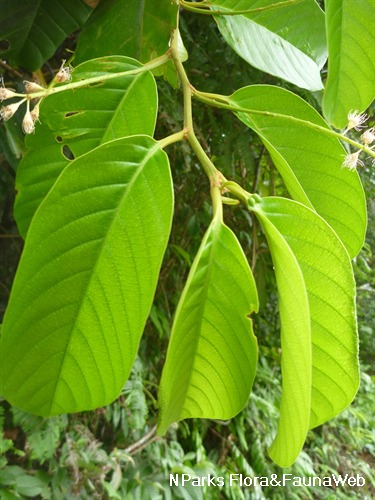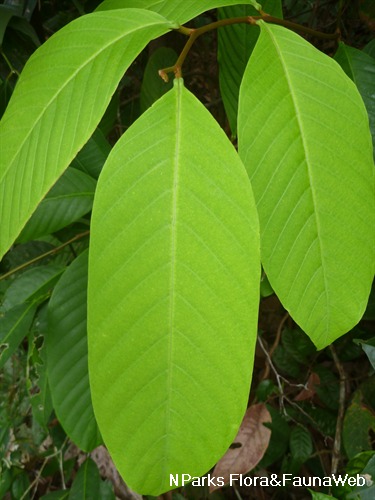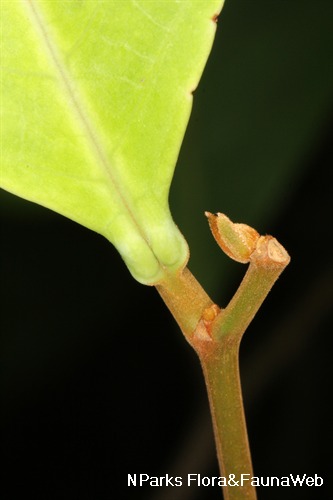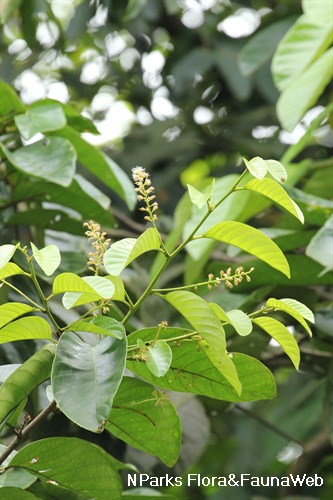
Back
Prunus polystachya (Hook.f.) Kalkman
| Family Name: | Rosaceae |
| Common Name: | Bat's Laurel, Medang Kelawar |
Name
Classifications and Characteristics
| Plant Division | Angiosperms (Flowering Seed Plants) (Dicotyledon) |
|---|---|
| Plant Growth Form | Tree (Big (>30m)) |
| Lifespan (in Singapore) | Perennial |
| Mode of Nutrition | Autotrophic |
| Plant Shape | Rounded, Conical |
Biogeography
| Native Distribution | Sumatra, Peninsular Malaysia, Singapore, and Borneo |
|---|---|
| Native Habitat | Terrestrial (Primary Rainforest, Secondary Rainforest, Freshwater Swamp Forest) |
| Preferred Climate Zone | Tropical |
| Local Conservation Status | Native to Singapore (Least Concern (LC)) |
Description and Ethnobotany
| Growth Form | It is a deciduous tree with a conical or round crown, up to 36 m tall. The occasionally buttressed tree has grey to black or blackish-brown bark. |
|---|---|
| Crown | Conical or round. |
| Trunk | Bark grey to black or blackish-brown. |
| Foliage | Its spirally arranged, stalked leaves have leathery leaf blades that are elliptic to elliptic-egg shaped, about 7–26 by 2.5–15 cm, and with a pair of glands present at the base of each leaf which emit a scent resembling almonds when crushed. Its leaf blades are green, and young leaves are pale green. |
| Flowers | Its flowering shoots are often branched and 3.5–11 cm long. Its white flowers have a rosy fragrance. |
| Fruit | Its green drupes are spherical to slightly broader than long and 13–21 by 17–27 mm. Its seeds have seed coats that may or may not be covered with hair. |
| Habitat | It grows in primary and secondary forests, up to 600 m in altitude. It occurs locally from Central Catchment Nature Reserve, Bukit Kallang, Bukit Timah Nature Reserve, and Nee Soon Swamp Forest. |
| Associated Fauna | Its flowers are insect-pollinated. |
| Cultivation | It can be propagated by seed. |
| Ethnobotanical Uses | Others: It has horticultural potential as a park tree. |
Landscaping Features
| Landscaping | It may be suitable for parks and gardens. |
|---|---|
| Desirable Plant Features | Ornamental Flowers, Fragrant |
| Landscape Uses | General, Parks & Gardens, Small Gardens |
Fauna, Pollination and Dispersal
| Pollination Method(s) | Biotic (Fauna) |
|---|---|
| Seed or Spore Dispersal | Biotic (Fauna) |
Plant Care and Propagation
| Light Preference | Full Sun, Semi-Shade |
|---|---|
| Water Preference | Moderate Water |
| Plant Growth Rate | Moderate |
| Rootzone Tolerance | Moist Soils, Well-Drained Soils, Fertile Loamy Soils |
| Propagation Method | Seed |
Foliar
| Foliage Retention | Evergreen |
|---|---|
| Mature Foliage Colour(s) | Green |
| Mature Foliage Texture(s) | Leathery |
| Prominent Young Flush Colour(s) | Green - Light Green |
| Young Flush Texture(s) | Leathery |
| Foliar Type | Simple / Unifoliate |
| Foliar Arrangement Along Stem | Alternate |
| Foliar Attachment to Stem | Petiolate |
| Foliar Shape(s) | Non-Palm Foliage (Ovate, Elliptical) |
| Foliar Venation | Pinnate / Net |
| Foliar Margin | Entire |
| Leaf Area Index (LAI) for Green Plot Ratio | 3.0 (Tree - Intermediate Canopy) |
Floral (Angiosperm)
| Flower & Plant Sexuality | Bisexual Flowers |
| Flower Colour(s) | White |
|---|---|
| Flower Grouping | Cluster / Inflorescence |
| Flower Location | Axillary |
Fruit, Seed and Spore
| Mature Fruit Colour(s) | Green |
|---|---|
| Mature Fruit Texture(s) | Smooth |
| Fruit Classification | Simple Fruit |
| Fruit Type |
Image Repository
Others
| Master ID | 1796 |
|---|---|
| Species ID | 3089 |
| Flora Disclaimer | The information in this website has been compiled from reliable sources, such as reference works on medicinal plants. It is not a substitute for medical advice or treatment and NParks does not purport to provide any medical advice. Readers should always consult his/her physician before using or consuming a plant for medicinal purposes. |

